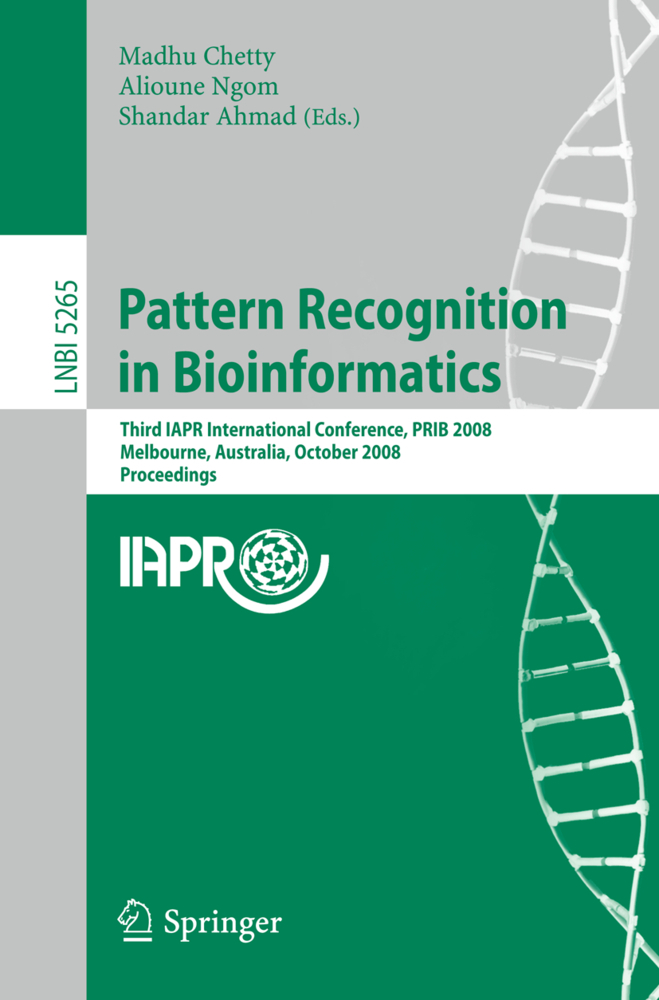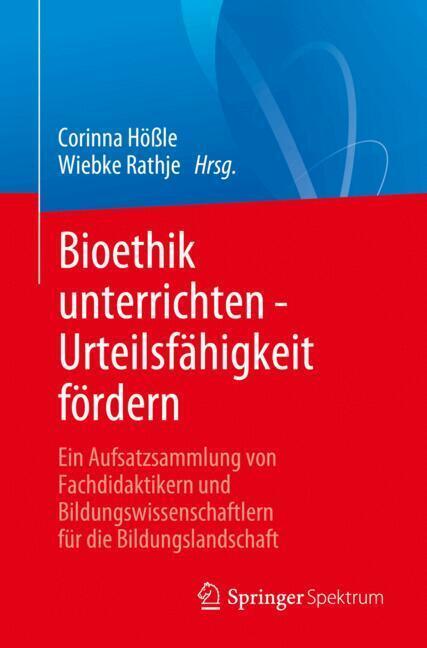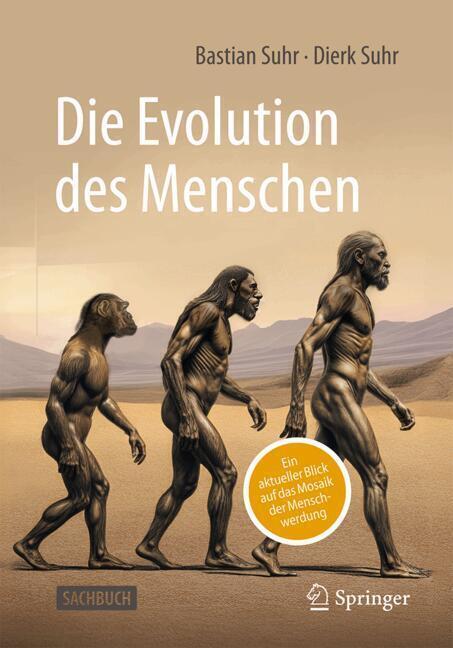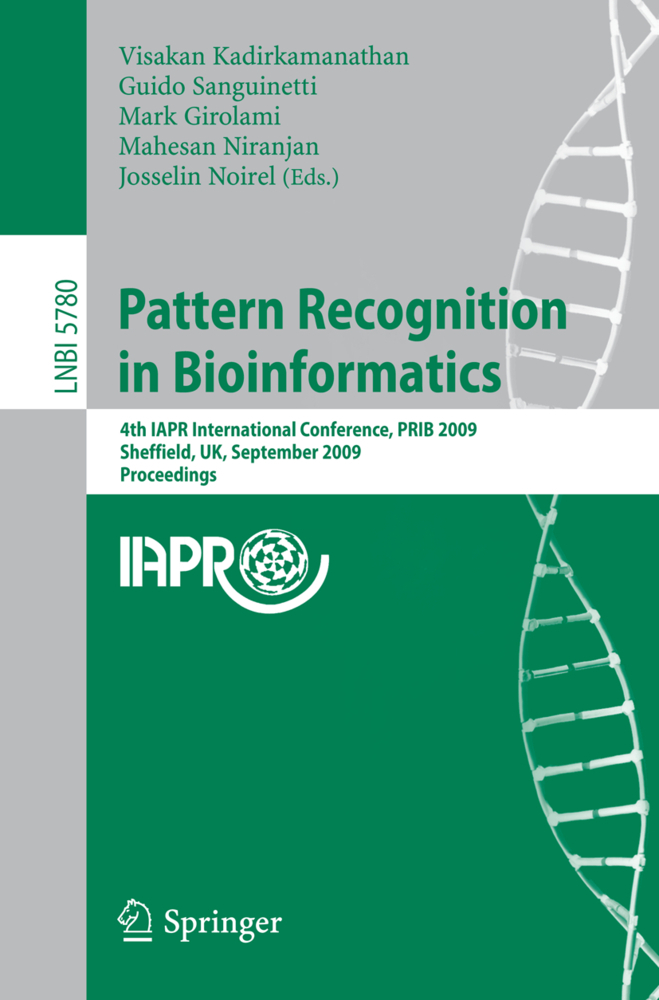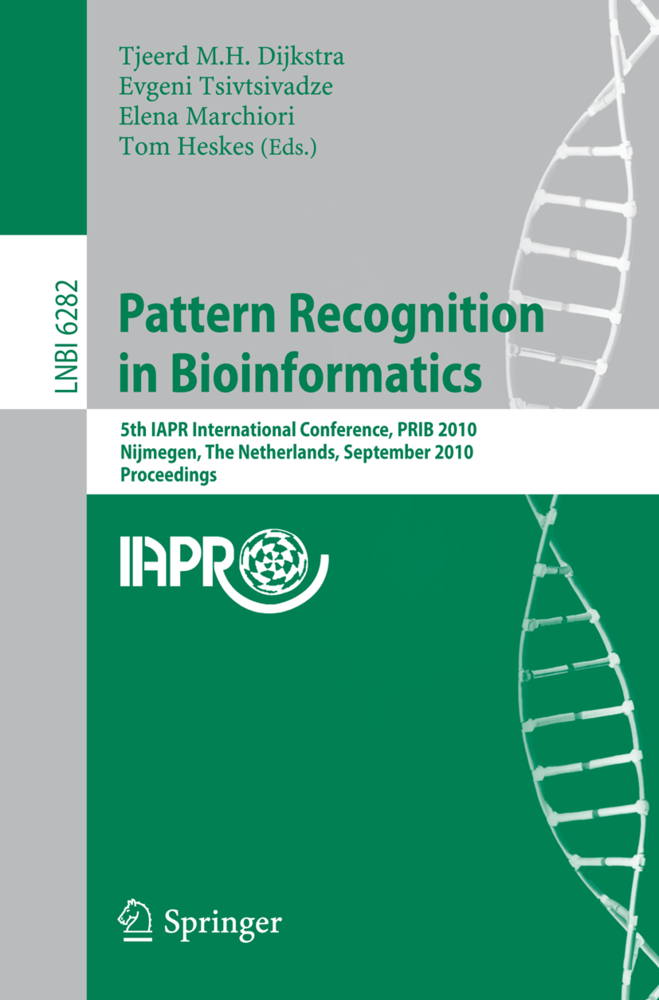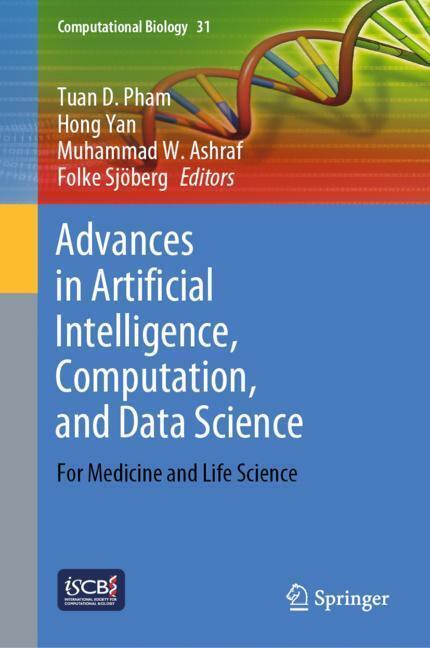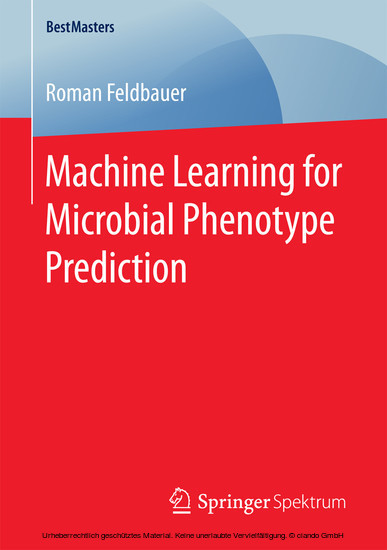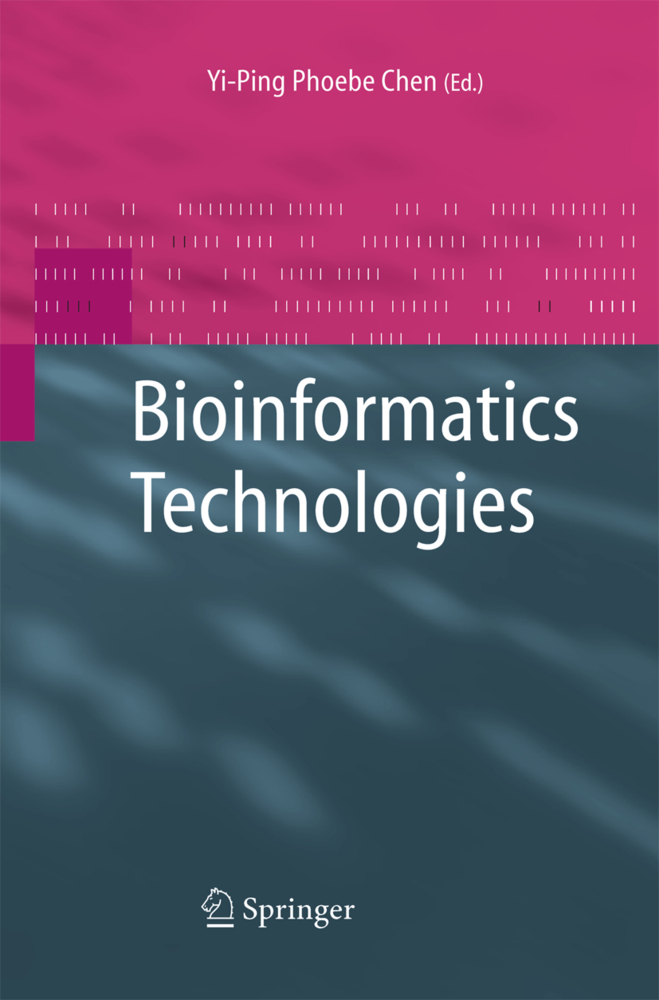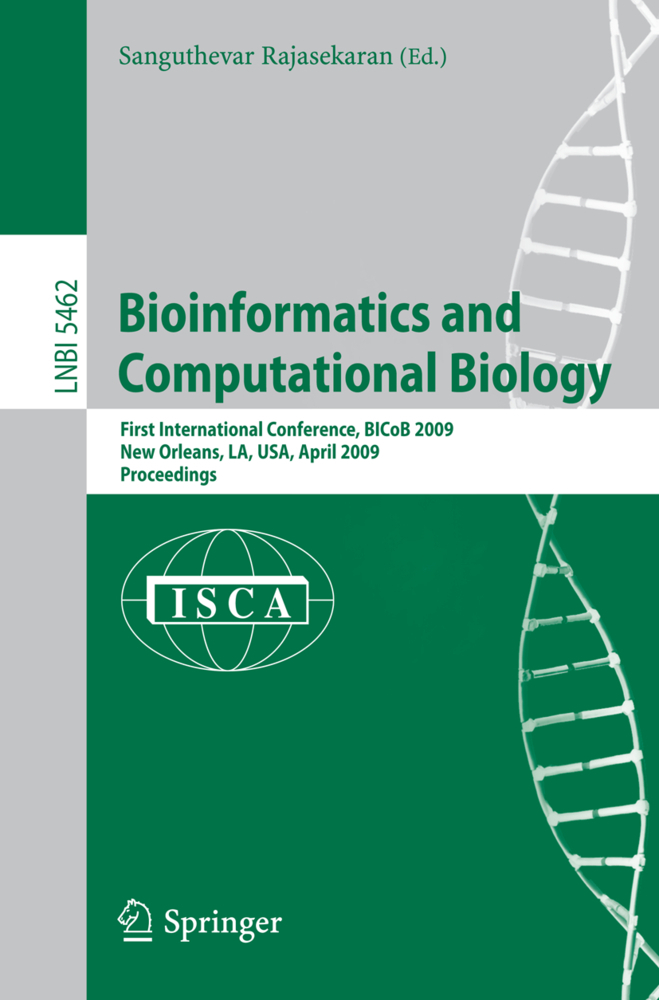Pattern Recognition in Bioinformatics
Third IAPR International Conference, PRIB 2008, Melbourne, Australia, October 15-17, 2008. Proceedings
Pattern Recognition in Bioinformatics
Third IAPR International Conference, PRIB 2008, Melbourne, Australia, October 15-17, 2008. Proceedings
In the post-genomic era, a holistic understanding of biological systems and p- cesses,inalltheircomplexity,is criticalincomprehendingnature'schoreography of life. As a result, bioinformatics involving its two main disciplines, namely, the life sciences and the computational sciences, is fast becoming a very promising multidisciplinary research ?eld. With the ever-increasing application of lar- scalehigh-throughputtechnologies,suchasgeneorproteinmicroarraysandmass spectrometry methods, the enormous body of information is growing rapidly. Bioinformaticians are posed with a large number of di?cult problems to solve, arising not only due to the complexities in acquiring the molecular infor- tion but also due to the size and nature of the generated data sets and/or the limitations of the algorithms required for analyzing these data. Although the ?eld of bioinformatics is still in its embryonic stage, the recent advancements in computational and information-theoretic techniques are enablingus to c- ductvariousinsilicotestingandscreeningofmanylab-basedexperimentsbefore these are actually performed in vitro or in vivo. These in silico investigations are providing new insights for interpretation and establishing a new direction for a deeper understanding. Among the various advanced computational methods currently being applied to such studies, the pattern recognition techniques are mostly found to be at the core of the whole discovery process for apprehending the underlying biological knowledge. Thus, we can safely surmise that the - going bioinformatics revolution may, in future, inevitably play a major role in many aspects of medical practice and/or the discipline of life sciences.
A Method to Find Sequentially Separated Motifs in Biological Sequences (SSMBS)
Predicting SUMOylation Sites
DFS Based Partial Pathways in GA for Protein Structure Prediction
Evaluation of the Stability of Folding Nucleus upon Mutation
Prediction of Protein Beta-Sheets: Dynamic Programming versus Grammatical Approach
Using Multi-scale Glide Zoom Window Feature Extraction Approach to Predict Protein Homo-oligomer Types
Extraction of Binding Sites in Proteins by Searching for Similar Local Molecular Surfaces
Learning, Classification, and Clustering
A Clustering Based Hybrid System for Mass Spectrometry Data Analysis
A Modified Markov Clustering Approach for Protein Sequence Clustering
Feature Selection and Classification for Small Gene Sets
Pseudoknot Identification through Learning TAGRNA
Support Vector Based T-Score for Gene Ranking
Prediction of Transcription Factor Families Using DNA Sequence Features
g-MARS: Protein Classification Using Gapped Markov Chains and Support Vector Machines
Bio-Molecular Networks and Pathways Analysis
Domain-Domain Interaction Identification with a Feature Selection Approach
Dividing Protein Interaction Networks by Growing Orthologous Articulations
Constraint Minimization for Efficient Modeling of Gene Regulatory Network
Fusion of Gene Regulatory and Protein Interaction Networks Using Skip-Chain Models
TopEVM: Using Co-occurrence and Topology Patterns of Enzymes in Metabolic Networks to Construct Phylogenetic Trees
Generating Synthetic Gene Regulatory Networks
Microarray and Gene Expression Analysis
Gene Selection for Microarray Data by a LDA-Based Genetic Algorithm
Sequential Forward Selection Approach to the Non-unique Oligonucleotide Probe Selection Problem
On Finding and Interpreting Patterns in Gene Expression Data from Time Course Experiments
Microarray Design Using the Hilbert-Schmidt Independence Criterion
Identifying Non-random Patterns from Gene Expression Profiles
A Study on the Importance of Differential Prioritization in Feature Selection Using Toy Datasets
Weighted Top Score Pair Method for Gene Selection and Classification
Data Mining and Knowledge Discovery
Identifying Conserved Discriminative Motifs
Exploratory Data Analysis for Investigating GC-MS Biomarkers
Multi-relational Data Mining for Tetratricopeptide Repeats (TPR)-Like Superfamily Members in Leishmania spp.: Acting-by-Connecting Proteins
Heuristic Non Parametric Collateral Missing Value Imputation: A Step Towards Robust Post-genomic Knowledge Discovery
Protein Expression Molecular Pattern Discovery by Nonnegative Principal Component Analysis
Gene Ontology Assisted Exploratory Microarray Clustering and Its Application to Cancer
Discovery of Biomarkers for Hexachlorobenzene Toxicity Using Population Based Methods on Gene Expression Data
Applications of High Performance Computing
Exploiting Fine-Grained Parallelism in the Phylogenetic Likelihood Function with MPI, Pthreads, and OpenMP: A Performance Study
Massively Parallelized DNA Motif Search on the Reconfigurable Hardware Platform COPACOBANA
GPU-MEME: Using Graphics Hardware to Accelerate Motif Finding in DNA Sequences
Accelerating BLASTP on the Cell Broadband Engine.
Protein: Structure, Function, and Interaction
Sequence Based Prediction of Protein Mutant Stability and Discrimination of Thermophilic ProteinsA Method to Find Sequentially Separated Motifs in Biological Sequences (SSMBS)
Predicting SUMOylation Sites
DFS Based Partial Pathways in GA for Protein Structure Prediction
Evaluation of the Stability of Folding Nucleus upon Mutation
Prediction of Protein Beta-Sheets: Dynamic Programming versus Grammatical Approach
Using Multi-scale Glide Zoom Window Feature Extraction Approach to Predict Protein Homo-oligomer Types
Extraction of Binding Sites in Proteins by Searching for Similar Local Molecular Surfaces
Learning, Classification, and Clustering
A Clustering Based Hybrid System for Mass Spectrometry Data Analysis
A Modified Markov Clustering Approach for Protein Sequence Clustering
Feature Selection and Classification for Small Gene Sets
Pseudoknot Identification through Learning TAGRNA
Support Vector Based T-Score for Gene Ranking
Prediction of Transcription Factor Families Using DNA Sequence Features
g-MARS: Protein Classification Using Gapped Markov Chains and Support Vector Machines
Bio-Molecular Networks and Pathways Analysis
Domain-Domain Interaction Identification with a Feature Selection Approach
Dividing Protein Interaction Networks by Growing Orthologous Articulations
Constraint Minimization for Efficient Modeling of Gene Regulatory Network
Fusion of Gene Regulatory and Protein Interaction Networks Using Skip-Chain Models
TopEVM: Using Co-occurrence and Topology Patterns of Enzymes in Metabolic Networks to Construct Phylogenetic Trees
Generating Synthetic Gene Regulatory Networks
Microarray and Gene Expression Analysis
Gene Selection for Microarray Data by a LDA-Based Genetic Algorithm
Sequential Forward Selection Approach to the Non-unique Oligonucleotide Probe Selection Problem
On Finding and Interpreting Patterns in Gene Expression Data from Time Course Experiments
Microarray Design Using the Hilbert-Schmidt Independence Criterion
Identifying Non-random Patterns from Gene Expression Profiles
A Study on the Importance of Differential Prioritization in Feature Selection Using Toy Datasets
Weighted Top Score Pair Method for Gene Selection and Classification
Data Mining and Knowledge Discovery
Identifying Conserved Discriminative Motifs
Exploratory Data Analysis for Investigating GC-MS Biomarkers
Multi-relational Data Mining for Tetratricopeptide Repeats (TPR)-Like Superfamily Members in Leishmania spp.: Acting-by-Connecting Proteins
Heuristic Non Parametric Collateral Missing Value Imputation: A Step Towards Robust Post-genomic Knowledge Discovery
Protein Expression Molecular Pattern Discovery by Nonnegative Principal Component Analysis
Gene Ontology Assisted Exploratory Microarray Clustering and Its Application to Cancer
Discovery of Biomarkers for Hexachlorobenzene Toxicity Using Population Based Methods on Gene Expression Data
Applications of High Performance Computing
Exploiting Fine-Grained Parallelism in the Phylogenetic Likelihood Function with MPI, Pthreads, and OpenMP: A Performance Study
Massively Parallelized DNA Motif Search on the Reconfigurable Hardware Platform COPACOBANA
GPU-MEME: Using Graphics Hardware to Accelerate Motif Finding in DNA Sequences
Accelerating BLASTP on the Cell Broadband Engine.
Chetty, Madhu
Ngom, Alioune
Ahmad, Shandar
| ISBN | 978-3-540-88434-7 |
|---|---|
| Artikelnummer | 9783540884347 |
| Medientyp | Buch |
| Copyrightjahr | 2008 |
| Verlag | Springer, Berlin |
| Umfang | XVI, 472 Seiten |
| Abbildungen | XVI, 472 p. |
| Sprache | Englisch |

